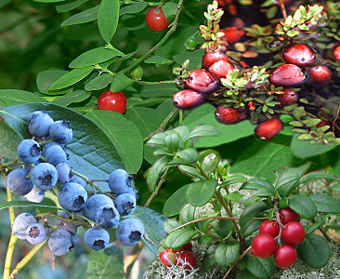Ericaceae
| Ericaceae | ||||||||||
|---|---|---|---|---|---|---|---|---|---|---|
Erica arborea
|
||||||||||
| Scientific classification | ||||||||||
|
||||||||||
| Genera | ||||||||||
|
See text. |
The plant family Ericaceae (also called the heath family or ericaceous plants) are mostly lime-hating (calcifuge) plants that thrive in acid soils. Many well-known plants of the Ericaceae live in temperate climates, such as cranberry, blueberry, heath, heather, huckleberry, azalea and rhododendron. However, the family also contains many tropical species.[1]
The Ericaceae family consists of herbs, shrubs and trees with leaves that are usually alternate, simple and without stipules, and hermaphrodite flowers. The flowers show considerable variability. The petals are often fused (sympetalous) with shapes ranging from narrowly tubular to funnelform or widely bowl-shaped. The corollas are usually radially symmetrical (actinomorphic) but many flowers of the genus Rhododendron are somewhat bilaterally symmetrical (zygomorphic).
Recent genetic research by the Angiosperm Phylogeny Group has resulted in the inclusion of the formerly recognised families Empetraceae, Epacridaceae, Monotropaceae, Prionotaceae and Pyrolaceae into Ericaceae. Most Ericaceae, except Monotropaceae, Prionotaceae and Pyrolaceae form ericoid mycorrhiza. This symbiotic relationship is considered crucial to the success of members of the family in edaphically stressful environments worldwide (Cairney and Meharg, 2003).
Genera

|
|
|
|
References
- ↑ See for example Kathleen A. Kron, E. Ann Powell and J. L. Luteyn (2002). "Phylogenetic relationships within the blueberry tribe (Vaccinieae, Ericaceae) based on sequence data from MATK and nuclear ribosomal ITS regions, with comments on the placement of Satyria". American Journal of Botany 89: 327–336. doi:. http://www.amjbot.org/cgi/content/full/89/2/327.
- Cairney, JWG & Meharg, AA (2003). Ericoid mycorrhiza: a partnership that exploits harsh edaphic conditions. European Journal of Soil Science 54, 735-740.
- Walters, Dick R. and David J. Keil. Vascular Plant Taxonomy. Kendall\Hunt: 1996, Dubuque
External links
- Ericaceae in Topwalks
- Ericaceae in L. Watson and M.J. Dallwitz (1992 onwards). The families of flowering plants.
- Neotropical blueberries reference at New York Botanical Garden (very detailed, keys to genera and species, etc.)
- Ericaceae Homepage, including a large number of photographs, cladograms, and descriptions.